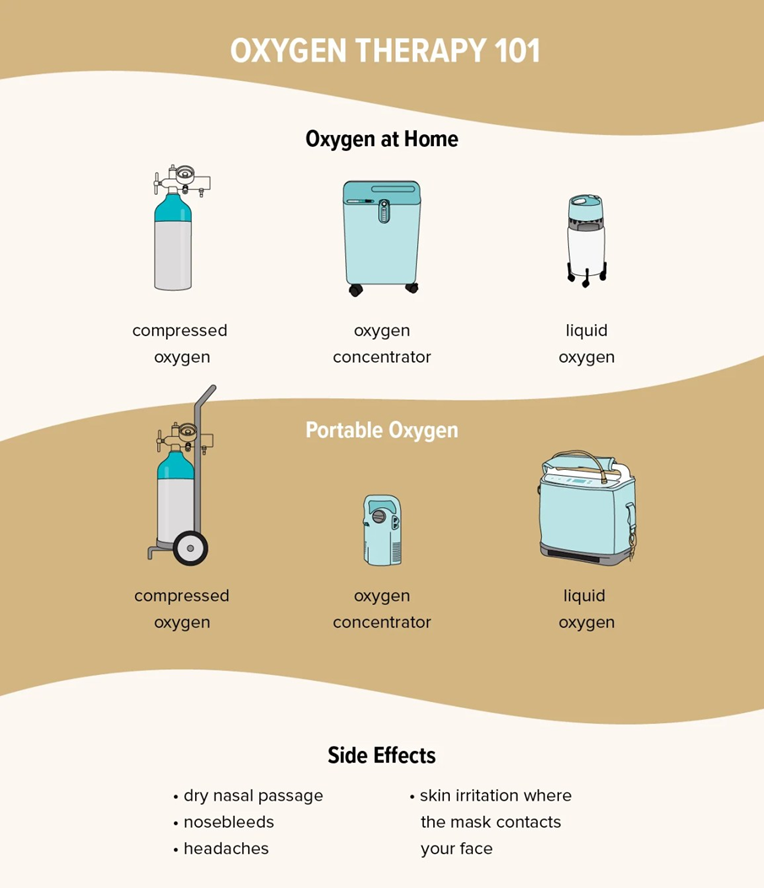A nurse is assisting with the care of a client in the emergency department who reports severe radiating chest pain and shortness of breath. The client appears restless, frightened, and slightly cyanotic. The provider prescribes oxygen by nasal cannula at 4 L/min stat, cardiac enzyme levels, IV fluids, and a 12-lead ECG. Which of the following actions should the nurse take first?
Attach the leads for a 12-lead ECG.
Obtain a blood sample.
Initiate oxygen therapy.
Insert the IV catheter.
The Correct Answer is C
Choice A reason: While attaching leads for a 12-lead ECG is important, it is not the most immediate action required for a client showing signs of distress and potential hypoxia.
Choice B reason: Obtaining a blood sample is necessary for diagnosing the cause of chest pain but is not the first priority in an emergency situation.
Choice C reason: Initiating oxygen therapy is the first and most critical step in managing a client with severe chest pain, shortness of breath, and cyanosis to ensure adequate oxygenation.

Choice D reason: Inserting an IV catheter is important for administering medications and fluids but comes after ensuring the client is receiving sufficient oxygen.
Nursing Test Bank
Naxlex Comprehensive Predictor Exams
Related Questions
Correct Answer is C
Explanation
Choice A reason: PregnancyWhile pregnancy can be associated with mood changes (such as postpartum depression), it is not considered a primary risk factor for depression. Pregnancy-related mood disorders are specific to the perinatal period and may not apply to all individuals.
Choice B reason: Male genderAlthough depression affects both men and women, research suggests that women are more likely to be diagnosed with depression. However, this does not make male gender a primary risk factor. Other factors play a more significant role.
Choice C reason: Chronic illnessThis is the correct answer. Chronic illnesses (such as diabetes, cardiovascular disease, autoimmune disorders, etc.) are associated with an increased risk of depression. The stress, lifestyle changes, and impact on overall well-being related to chronic illness contribute to this risk.
Choice D reason: Being marriedBeing married is not necessarily a primary risk factor for depression. Relationship status alone does not determine depression risk. Factors such as marital satisfaction, social support, and individual coping mechanisms play a more significant role.
Correct Answer is B
Explanation
Choice A reason: Interrupted electrical activity to areas of the heartWhen it comes to the pain associated with coronary artery disease (CAD), interrupted electrical activity is not the primary cause. While abnormal electrical activity can lead to arrhythmias, it is not the primary source of pain in CAD. The pain in CAD is primarily related to inadequate blood flow and oxygen supply to the heart muscle.
Choice B reason: Lack of sufficient oxygen to the myocardiumThis is the correct answer. Coronary artery disease results in the narrowing or blockage of coronary arteries, which supply oxygen-rich blood to the heart muscle. When these arteries become narrowed due to plaque buildup (atherosclerosis), the heart muscle does not receive enough oxygen. This insufficient oxygen supply leads to chest pain (angina) and discomfort.
Choice C reason: Increased cardiac workloadWhile increased cardiac workload can contribute to heart-related symptoms, it is not the primary cause of pain in coronary artery disease. Increased workload may occur during physical exertion or stress, but the underlying issue in CAD is the reduced blood flow due to narrowed or blocked arteries.
Choice D reason: Lack of nutrients into the heartWhile nutrients are essential for overall heart health, the primary concern in coronary artery disease is the lack of oxygen supply. The pain associated with CAD is primarily related to inadequate oxygen delivery to the heart muscle, not specifically a lack of nutrients.
Whether you are a student looking to ace your exams or a practicing nurse seeking to enhance your expertise , our nursing education contents will empower you with the confidence and competence to make a difference in the lives of patients and become a respected leader in the healthcare field.
Visit Naxlex, invest in your future and unlock endless possibilities with our unparalleled nursing education contents today
Report Wrong Answer on the Current Question
Do you disagree with the answer? If yes, what is your expected answer? Explain.
Kindly be descriptive with the issue you are facing.
